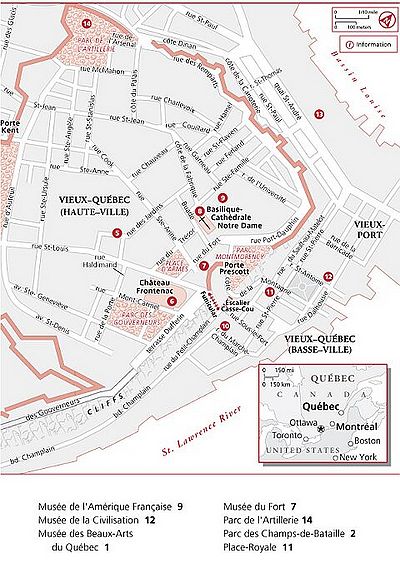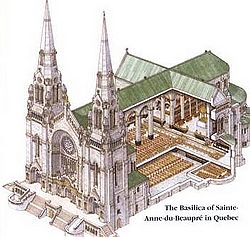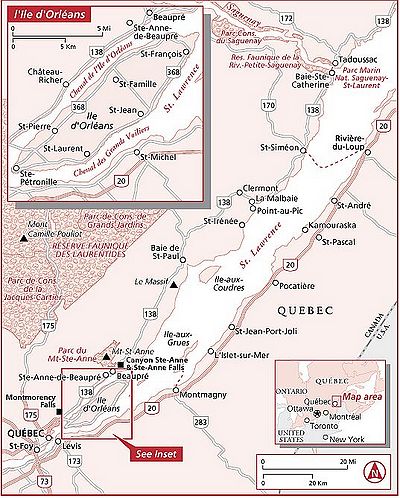Quebec City
 From Conservapedia
From Conservapedia Quebec City (Ville de Québec in French) is the second largest city and capital of the Canadian province Quebec.
Contents
History[edit]
The French explorer and leader Samuel de Champlain founded a settlement at Quebec in 1608, although earlier settlements had been attempted, the first in 1535, although harsh winters and hostile natives prevented a city from flourishing. The fate of Canada was decided in Quebec in 1763 during the Seven Years' War when the British army under General James Wolfe defeated the French general Louis-Joseph de Montcalm and took the city. France ceded New France to Britain.
The Americans tried to capture the city in 1775. British Forts Chambly and St. Johns, located southeast of Montreal, fell to a prolonged American siege under General Richard Montgomery that sufficiently delayed and thereby doomed the subsequent American winter siege of Quebec City.
19th century decline[edit]
Quebec City dominated Lower Canada as the seat of government in that province (except for 1844-49) as well as the center of many religious institutions, including the only Canadian Catholic diocese until 1836. In the Catholic Church, it became the center of the Liberal-Ultramontane controversy. The establishment of the national capital at Quebec in 1859 restored the city to dominance, and led to an influx of intellectuals. When Ottawa was made the capital in 1865, Quebec City lost its importance.
During the first half of the 19th century, Quebec City experienced significant economic and demographic growth. Nevertheless, by 1860, a crisis had already set in, one that lasted until the end of the century and was due to the collapse of the city's economic foundations. It was a period of social and economic stagnation for the city, even though it remained the capital of the province of Quebec.
World War I[edit]
The city—indeed the entire province—was on the verge of civil war in 1918, as shown by the violent Easter Riots in Quebec City between 28 March and 1 April 1918. The riots demonstrated French-Canadian anger with the national war effort in World War I and the introduction of conscription. The French of Quebec refused to join the army and rejected the draft. The riots raised nationwide fears that a state of rebellion existed in the French-speaking province of Quebec. The Canadian government's reaction was immediate and firm; martial law was proclaimed, habeas corpus was suspended, and over six thousand English-speaking soldiers were deployed to Quebec during and after the riots to maintain order and enforce conscription, the last of these troops leaving the province in early 1919. The Easter Riots were extremely violent, causing important destruction of property and over 150 civilian and military casualties, including at least four dead when soldiers opened fire on rioters.[1]
Quiet Revolution[edit]
1960 was the most significant year in modem Quebec history because it began the Quiet Revolution. The 1960 election marked the birth of a new society—democratic, secular, outward-looking—replacing almost overnight the highly traditionalistic autocratic, Jansenist Catholicism. The new society ignored Canadian nationalism and promoted Quebec nationalism, demanded the use of the French language, and repelled and drove out many English speakers ("Anglophones"). Large business corporations moved to English-speaking Ontario. Liberation from the Catholic Church came along with liberation from British-Canadian traditions and values.
Consumerism[edit]
Quebec City fully joined the consumer society in the second half of the 20th century. Shopping centers first appeared in the near suburbs. Linked to the use of cars, they offered strong competition for older commercial streets found in central neighborhoods and in the small towns and villages gradually surrounded by suburban expansion. A multilevel hierarchy of shopping centers developed over the years, with so-called big boxes being the most recent addition.
Politics[edit]
Two local political cultures, municipal interventionism and fiscal populism, faced off against each other in November 2001 in the first election to be held in the newly merged Quebec City. While municipal interventionism, advocated by a new party formed mainly from within the former central city, carried the race for mayor, it was fiscal populism, the platform of another newly formed party built mainly on a suburban base, that gained the majority of the city councilors' positions.
Tourism[edit]
Tourists visiting leading heritage sites are heirs to 19th century gentry tourism. Well-to-do Americans and Europeans started traveling to Canada in the 1830s. Quebec City was as early as the 18th century a much reputed town and even a symbol because of its exceptional site and situation.The City is unique in North America as the old part of the city is surrounded by city walls and fortifications. A large hotel, the Chateau Frontenac over looks the narrowing of the Saint Lawrence River and the entire city. The upper town belonged to businessmen, priests, and politicians, the lower town was home to sailors, whores, and criminals. The cliffs separating the two towns were deemed unscalable, but in recent decades gentrification has cleaned out the old crime-ridden slums in "basse ville" (the lower city). Even old-time, tubercular, working-class areas like Limoilou have been upgraded to international tourist standards. Hotels and restaurants have been carved from former residences. The churches have become quiet museums. Laval University has moved to the suburbs.
The city is well known for its winter festival, The Carnaval de Québec, has been held every February since 1894.[2] Québec city celebrated its 400th anniversary in 2008.
Tourist Information[edit]
Québec city was named a UNESCO World Heritage Site in 1985.[3]
Media[edit]
Note: All stations in Quebec City broadcast in French unless otherwise indicated
FM Radio[edit]
- 88.3 - CKIA (Community radio)
- 89.1 - CKRL (Community radio)
- 90.9 - CION (Religious)
- 91.9 - CJEC (Adult contemporary)
- 92.7 - CJSQ (Classical music)
- 93.3 - CJMF (Active rock)
- 94.3 - CHYZ (College radio)
- 95.3 - CBVX (Ici Musique)
- 98.1 - CHOI (Talk radio)
- 98.9 - CHIK (Top 40)
- 100.3 - CIHW (First Nations radio; French/Montagnais)
- 100.9 - CHXX (Modern rock)
- 102.1 - CFEL (Hot adult contemporary)
- 102.9 - CFOM (Oldies)
- 104.7 - CBVE (CBC Radio One; English)
- 106.3 - CBV (Ici Radio-Canada Première)
- 107.5 - CITF (Soft adult contemporary)
Television[edit]
- 2.1 - CFAP (Noovo)
- 4.1 - CFCM (TVA)
- 11.1 - CBVT (Ici Radio-Canada Télé)
- 15.1 - CIVQ (Télé-Québec; educational)
Quebec City also once had an English-language TV station, CKMI-TV (now CKMI-DT), which signed on in 1957 as a privately-owned CBC affiliate and sister station to CFCM. CKMI switched affiliations to Global TV and relocated its studios to Montreal in 1997, followed by switching its city of license to Montreal in 2009, but continues to maintain a rebroadcaster of the station in Quebec City.
See also[edit]
References[edit]
- ↑ Martin F. Auger, "On the Brink of Civil War: The Canadian Government and the Suppression of the 1918 Quebec Easter Riots," Canadian Historical Review 2008 89(4): 503-540
- ↑ http://www.carnaval.qc.ca/histoire.html
- ↑ http://www.bonjourquebec.com/qc-en/villesquebec0.html
Categories: [Canadian Cities and Towns] [Quebec] [Urban History] [Canadian History]
↧ Download as ZWI file | Last modified: 02/16/2023 15:54:06 | 30 views
☰ Source: https://www.conservapedia.com/Quebec_City | License: CC BY-SA 3.0
 ZWI signed:
ZWI signed:


 KSF
KSF